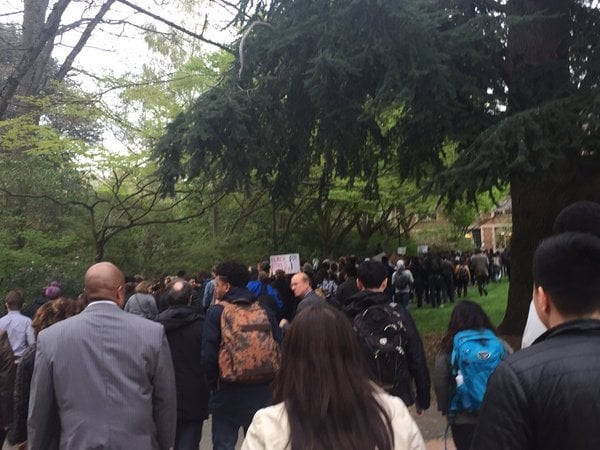You have /5 articles left.
Sign up for a free account or log in.

Professor Michael Thornton with his students at University of Wisconsin at Madison
Bryce Richter / UW-Madison
The first recommendation of the American Academy’s recent report "The Future of Undergraduate Education" is simple: we should work to improve undergraduate instruction.
But how? In many disciplines, we don’t have rigorous measures of learning, so we cannot easily identify the best practitioners and simply copy what they do. Undergraduate students, however, experience numerous teachers and a lot of instruction, some good and some bad. They are a source of valuable information about what constitutes good practice.
So, at a recent event co-sponsored by the Center for Ethics and Education, the University of Wisconsin at Madison College of Letters and Science, and the American Academy, we asked five undergraduate students at the university to describe instructional practices that they’ve encountered rarely but were especially effective -- and that they think should be more widely shared. Of course, some strategies work in some disciplines better than others, in some kinds of classes better than others and for some instructors better than others. Here’s what the students at the event told us.
Christian Cuevas, a senior majoring in computer science: One strategy that more professors should use, especially in STEM classes but also anytime a complex solution or process needs to be explained, is to explain all the details. While that can result in professors covering information that may seem painfully obvious to them, it saves students confusion. When professors skip over steps of a problem and only focus on those they feel are the most crucial or important, it puts the burden on students to connect the dots in their heads, while still trying to pay attention to the stream of information in the lecture.
Few steps in a solution are obvious to students who have never encountered a similar problem before. Even if some steps are easy to figure out upon reflection, students lack the bandwidth to reflect while also taking notes and ingesting the lecture. Skipping steps risks students leaving the classroom with little understanding and having to put the scattered pieces together on their own.
By covering solutions in their entirety, professors allow their students to focus on absorbing the complex new information in front of them. That frees students to ask questions and leaves them with complete examples in their notes, which can be crucial when they are trying to solve similar problems in their homework or when studying for exams.
Imagine you were trying to bake a cake and you had never done it before. Suppose that the recipe skipped directly from beating the eggs to putting the finished batter in the oven, ignoring all the steps in between. You would fail! The missing steps might be intellectually uninteresting to the master baker, but the novice baker has to learn them. Just as we need to be guided through every detail when baking a cake for the first time, we also need thorough guidance when approaching a difficult calculus or physics problem for the first time.
Alexis Argall (B.A. 2018), a political science and communication and life sciences major: At a large research institution like UW Madison, it is easy to feel like “just another number.” Many professors would like to know their students personally but don’t know how to do it; others seem to share information with students and then forget about them until next class period. Yet a professor in one of my classes used a strategy that others should try.
Participation was worth 30 percent of our grade, and it included a requirement to email the professor weekly with a connection that we had made between something that we’d discussed in class and something outside of it. That connection could come from another course or from our personal lives -- anything that made us stop and remember what we had learned that week. It forced me to think about the material outside of class and helped me find practical applications for what I was learning.
We were not graded rigidly on the content of our emails but rather just that we had made some sort of meaningful connection. Grading them on a submission basis rather than a content basis saved a lot of time for my professor, while still pressing us to process the information.
For my professor, the benefit was learning more about us as “whole people” rather than just students in her class. It gave her a more holistic view of us students, as well as forced us to actively process what we were learning. The requirement made us learn more, and the sense that the professor knew who we were made us want to learn more.
Joe Venuta (B.A. 2018), a philosophy major: One valuable lesson I’ve learned has been how to approach negative feedback. Specifically, I have come to realize the value in engaging with criticism and improving the work on which it is given. And I would not have discovered this without professors whose classes required me to do so.
In many classes, faculty members give comments on assignments in writing along with the final grade. While that kind of feedback can be a tool for improvement, it is too easy for students to brush comments off and simply keep those things in mind for next time rather than consider how they might be addressed. Furthermore, students often see such comments as the instructor’s justification for giving a less than perfect score rather than what it really is: an opportunity to improve that particular assignment.
My professors have used two main strategies for inducing students to process negative feedback. One was to require the submission of a draft in advance. While successful students often work through multiple drafts anyway, submitting a draft for review forces them to consider major weaknesses in their assignment that they may otherwise overlook. In addition, submitting an improved final draft after responding to any criticism can help show students the value and achievability of addressing shortcomings.
Another strategy is through in-person conferences. A back-and-forth discussion requires students to face specific criticisms head-on. It also allows them to become more comfortable with defending their work while staying composed -- a valuable skill in any field. While in-person conferences do require more time from both the student and professor, a conversation lasting even 15 minutes can help.
Personalized criticism from professors is a valuable resource, one that is too rarely used. Whether through multiple drafts or in-person discussions, engaging with negative feedback can benefit students in any area of study.
Kailey Mullane, a sophomore majoring in communication arts and economics: My first thought when I was invited to speak was, “I am not qualified to be giving world-renowned professors technical teaching strategies that will solve all their classroom problems.” But then I thought about what makes classes valuable to me. Numerous factors come into play: material, class size, other students and so on. However, I realized that one simple thing consistently makes classes better: when teachers make the students introduce themselves at the start of each class period in the first few weeks.
Students introducing and saying a little bit about themselves (like majors and hometowns) really changes the dynamic. Knowing a classmate’s name instantly creates a more inviting environment and is the first step in developing a relationship. In those classes, I notice that instead of sitting silently staring at screens, students actually talk to one another before class starts. They talk during class: students are more willing to offer comments, ask questions and disagree with one another. And they talk to each other outside of class, often about the material -- which means there is more outside learning.
Time is precious. But in small classes, introductions take just three to five minutes. Large lectures are more difficult, but TAs can effectively administer that process in discussion sections. Just taking time at the start of each class to have students introduce themselves can have invaluable effects in and beyond the classroom.
Chlodagh Walsh, (B.B.A. 2018), a finance, investment and banking major: My first semesters of college were filled with mostly large lecture classes, the "weed out" type that could ruin your GPA or force you to change your major. On the first day of class, professors would outline the predetermined curves and tell us exactly how many students would receive A's, regardless how much we learned. One professor told us that, while we should be able to complete 80 percent of the exams using his lectures, we could not prepare for the more nuanced application of the material that constituted the remaining 20 percent.
The first class in my major was accompanied by a 19-page syllabus that we were tested on. The professor graded us based on our class rank; if you did better than half of the 300-person class, you received a grade of 50 percent. He set the grading practices to mimic the business world that we were set to enter: cutthroat and ultracompetitive. The syllabus stated that if you aced an exam, the professor would take you out to dinner -- as far as I know, he has never had to follow through. Most class participation was involuntary; the professor cold-called students unsystematically, so we shied away from wearing clothing that might draw his attention. I found a good hiding place, just outside his usual line of sight.
I had a different class in the same room a year later. It was another large, entry-level class that was subject to the GPA restrictions of the business school, which sets a maximum average class GPA of 3.0. So I was pretty surprised when the professor said she had hoped to see high test averages. She explained that our test scores were an indication of her teaching; if she were doing her job right, we should score well.
She made me view my GPA as a reflection of not only my effort but also the quality of the instruction I was receiving. The way she framed the class from the beginning emphasized our learning ahead of grades, which I came to understand are not synonymous.
Since many people performed well, the letter grade differentials at the high end reflected the GPA regulations more than student competencies. I can understand the business school may have reasons to regulate govern grading, so I was not frustrated by that. Instead, with the help of the professor, I learned to value the knowledge and skills -- the learning -- that I gained more than whatever direction my GPA moved after finals.
Students admired this professor and volunteered topics to discuss at the onset of each class. She invited us to her office hours and made us welcome when we came. The TAs spoke highly of her in discussion sections. The atmosphere was remarkably different than the lecture style I was used to and reduced the interstudent competition that other large classes encouraged. I wasn’t afraid of being caught off guard and embarrassed by answering a question wrong, so I didn’t need to hide in class or avoid eye contact. The environment made us less afraid of failing and more intellectually ambitious.
I applied this perspective to other classes, regardless of each professor's structure. I was less stressed about exam scores and more concerned about my actual understanding. As a self-identified really good crammer, I had perfected scoring high and learning little for years, but that seemed less attractive now.
Knowing my class standing was less interesting, too: my own learning was what mattered. I have found most students succeed when professors don’t intend to intimidate, reduce the reliance on grades as a measure of success, and identify student learning as the measure of their own success.
*******
One point of publicizing these students’ comments is just to provide good additions to the instructors’ toolbox. Of course, for any suggestion, the instructor has to reflect on whether it will work for them, in their discipline and in their situation. The second point is to encourage administrators and instructors to seek out and disseminate considered student suggestions. Thoughtful students are invaluable resources when we are looking to improve, and their insights are solicited too rarely.







